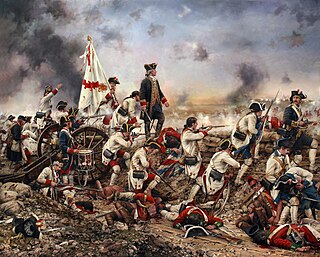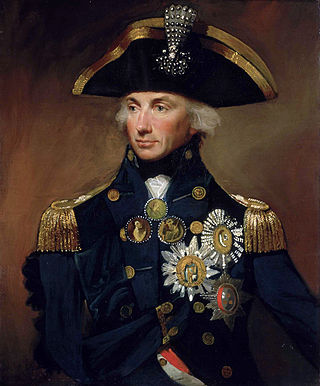The 79th Regiment of Foot (Royal Liverpool Volunteers) was an infantry regiment of the British Army, also known as the Liverpool Blues, which served in the Americas during the American War of Independence.

El Castillo is a municipality located on the Río San Juan in the Río San Juan Department of Nicaragua. The settlement of what would eventually become the municipality of El Castillo began in 1673, when construction of the Fortaleza de la Limpia Pura e Inmaculada Concepción, was begun. The village of El Castillo eventually grew around the fortress, which continued to be strategically important to the Captaincy General of Guatemala until the late 18th century.

Spain, through its alliance with France and as part of its conflict with Britain, played a role in the independence of the United States. Spain declared war on Britain as an ally of France, itself an ally of the American colonies. Most notably, Spanish forces attacked British positions in the south and captured West Florida from Britain in the siege of Pensacola. This secured the southern route for supplies and closed off the possibility of any British offensive through the western frontier of the United States via the Mississippi River. Spain also provided money, supplies, and munitions to the American forces.
Events from the year 1780 in Great Britain.

Yerba Buena was the original name of the settlement that later became San Francisco. Located near the northeastern end of the San Francisco Peninsula, between the Presidio of San Francisco and the Mission San Francisco de Asís, it was originally intended as a trading post for ships visiting San Francisco Bay. The settlement was arranged in the Spanish style around a plaza that remains as the present day Portsmouth Square.

The Battle of Porto Bello, or the Battle of Portobello, was a 1739 battle between a British naval force aiming to capture the settlement of Portobelo in Panama, and its Spanish defenders. It took place during the War of the Austrian Succession, in the early stages of the war sometimes known as the War of Jenkins' Ear. It resulted in a popularly acclaimed British victory.
HMS Hinchinbrook was the French privateer Astrée, which the British captured in 1778 and took into the Royal Navy as a 28-gun sixth-rate frigate. She was Captain Horatio Nelson's second navy command, after the brig HMS Badger, and his first as post-captain. She was wrecked, with no loss of life, in January 1783.

Vice-Admiral Horatio Nelson, 1st Viscount Nelson, 1st Duke of Bronte was a British flag officer in the Royal Navy. His inspirational leadership, grasp of strategy and unconventional tactics brought about a number of decisive British naval victories during the French Revolutionary and Napoleonic Wars. He is widely regarded as one of the greatest naval commanders in history. His victory on 21 October 1805 at the Battle of Trafalgar led to British naval supremacy for over another century and beyond.

The Assault on Cádiz was a part of a protracted naval blockade of the Spanish port of Cádiz by the Royal Navy, which comprised the siege and the shelling of the city as well as an amphibious assault on the port itself from June to July 1797. After the battle of Cape Saint Vincent the British fleet led by Lord Jervis and Sir Horatio Nelson had appeared in the Gulf of Cádiz. In the first days of June the city was bombarded, causing slight damage to the Spanish batteries, navy and city. Nelson's objective was to force the Spanish admiral Jose Mazarredo to leave the harbour with the Spanish fleet. The Spanish response was to build gunboats and small ships to protect the entrance of the harbour from the British. By early July, after a series of failed attacks led by Rear Admiral Nelson, and with the British ships taking huge fire from the Spanish forts and batteries, the British withdrew and the siege was lifted. The naval blockade, however, lasted until 1802.

The Capture of the Bahamas took place in May 1782 during the American Revolutionary War when a Spanish force under the command of Juan Manuel Cagigal arrived on the island of New Providence near Nassau, the capital of the Bahamas. The British commander at Nassau, John Maxwell decided to surrender the island without a fight when confronted by the superior force.

The Battle of Fort Mose was a significant action of the War of Jenkins' Ear that took place on June 14, 1740 in Spanish Florida. Captain Antonio Salgado commanded a Spanish column of 300 regular troops, backed by the free black militia under Francisco Menéndez and allied Seminole warriors consisting of Indian auxiliaries. They stormed Fort Mose, a strategically crucial position newly held by 170 British soldiers under Colonel John Palmer. Palmer and his garrison had taken the fort from the Spanish as part of James Oglethorpe's offensive to capture St. Augustine.

El Castillo is a village of about 1,500 people situated on the southern bank of the Río San Juan in southern Nicaragua. It is one of 27 comarcas of the municipality of El Castillo, a subdivision of the Río San Juan Department. The village is situated approximately 6 kilometers from the border with Costa Rica, at the Raudal del Diablo rapids of the San Juan River. The site on which the village of El Castillo is built was initially established in 1673 as a Spanish fortification to defend against pirate attacks upon the city of Granada. The settlement of El Castillo and its fortress continued to be strategically important to the Captaincy General of Guatemala until the late 18th century.

The Battle of Pinos was a naval engagement between a Spanish fleet under Admiral Bernardino Delgadillo y Avellaneda and the surviving ships of Francis Drake's expedition to the Spanish West Indies, now in command of Drake's lieutenant, Sir Thomas Baskerville, which took place off the Island of Pinos during the Anglo-Spanish war of 1585. The Spanish squadron was victorious, capturing two English ships.

The Fortress of the Immaculate Conception, is a fortification located on the southern bank of the San Juan River, in the village of El Castillo in southern Nicaragua. The fortress is situated approximately 6 kilometers from the border with Costa Rica, at the Raudal del Diablo rapids of the San Juan River. It was completed in 1675 as part of a series of fortifications along the San Juan River, to defend against pirate attacks upon the city of Granada. The settlement of El Castillo and its fortress continued to be strategically important to the Captaincy General of Guatemala until the late 18th century.

The Capture of Fort Rocher took place on 9 February 1654, during the Franco-Spanish War (1635–1659). Equipped with one siege battery, a Spanish expedition of 700 troops attacked the buccaneer stronghold of Tortuga, capturing the Fort de Rocher and 500 prisoners including 330 buccaneers and goods valued at approximately 160,000 pieces-of-eight. The Spanish burned the colony to the ground and slaughtered its inhabitants, leaving behind a fort manned by 150 soldiers. They possessed the island for about eighteen months, but on the approach of the expedition under Penn and Venables were ordered by the Conde de Peñalva, Governor of Santo Domingo, to demolish the fortifications, bury the artillery and other arms, and retire to his aid in Hispaniola.

The battle for Río San Juan de Nicaragua was one of several battles that took place during the Anglo-Spanish War, a subconflict of the Seven Years' War, which lasted from December 1761 until February 1763. The conflict, which took place in July–August 1762, began when William Lyttelton, the British governor and commander-in-chief of Jamaica, sent a naval expedition to Nicaragua with the primary objective of capturing the town of Granada.

Watts' West Indies and Virginia expedition also known as the Action of Cape Tiburon was an English expedition to the Spanish Main during the Anglo–Spanish War. The expedition began on 10 May and ended by 18 July 1590 and was commanded by Abraham Cocke and Christopher Newport. This was financed by the highly renowned London merchant John Watts. The English ships intercepted and dispersed Spanish convoys capturing, sinking, and grounding many ships off the Spanish colonies of Hispaniola, Cuba, and Jamaica. Despite losing an arm, Newport was victorious and captured a good haul of booty. A breakaway expedition from this discovered that the Roanoke Colony was completely deserted and which gave the name The Lost Colony.
Juan Francisco Machado was the governor of the then Spanish colony Trinidad from 1781 to 1784.
The Raid on Matina or the Battle of Matina was a small but significant military engagement that took place on 13 August 1747 between British Baymen and Miskito from the Mosquito Coast and Spanish forces over the Spanish fortification at Matina in the Captaincy General of Guatemala. The engagement was part of a larger conflict which was known as the War of Jenkins' Ear. The British and Miskito destroyed the fort after a short sharp fight before destroying the crops and taking away plunder from the surrounding Cacao rich area.
Antonio Barreto was the governor of the then Spanish colony Trinidad from January or June 1784 until August 1784.













